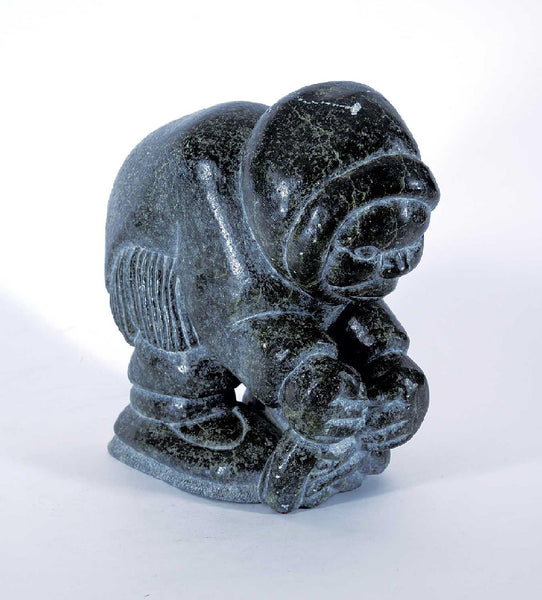Charlie Inukpuk
Inukjuak/Port Harrison
His story:
Charlie Inukpuk, eldest son of Johnny Inukpuk, was born in 1941 in Kotak, north of Inukjuak. His family moved into Inukjuak so that the children could attend school. He began carving as a teenager in the 1950s. In an interview with Louis Gagnon recorded in Inukjuak in 1995 (published in an 1996 article for Inuit Art Quarterly [IAQ]), Inukpuk said, "I learned by watching... my father and other carvers, back then when we lived in the camps where there were no White people." His recollection is that people could make 10 or so small carvings in a week in the early years. "When we lived in Nauligaqvik, where I first learned to carve, we could get soapstone from the point. I don't recall exactly what my very first carving was. Back then we just carved" (ibid., 13). By the late 1970s, finding it hard to support himself by carving, Inukpuk stopped producing. He even stopped, for a time, making the soapstone heads used by his wife, Elisapee, in her authentically dressed doll sculptures. "I stopped making carvings when the buying of carvings ended. It seemed there were no more buyers, so I joined the labour force. But sometimes, someone from the South specifically asks me to make a carving and I do so" (ibid.). He has retuned intermittently to carving, occasionally making heads for his wife's dolls or stone handles for her baskets.
About his art:
Charlie Inukpuk told Louis Gagnon: "When I first started carving, the main challenge was determining the hardness of the soapstone since the density varies. It was easier to work with the softer stone. I would start by axe-chipping it, and as I was doing this I would start visualizing it. The shape of the stone also provided me with ideas. As I axed it gradually, my thoughts would go: 'This is shaping like this... It is going to be...' and the carving being formed would follow my thoughts from there. ...We used shoe polish [to darken the stone] because it made the carvings more attractive and shiny. We used to polish the carving by getting it hot and then applying the polish. When it was freshly polished, it looked very attractive" (ibid.). A distinguishing feature of Inukpuk's figures is their large hands. According to Inukpuk, the reason for the oversized hands was that when the soapstone "felt too fragile" he compensated for the stone's weakness by leaving more stone behind (ibid). Regarding his carving technique specifically, Maria von Finckenstein wrote in 1998 (Inuit Art Quarterly): "Unlike his father, Johnny, who worked in large, smooth, and restful volumes, Inukpuk breaks up the surface of his sculptures through a high degree of modulation" (p. 46). About his subject matter, Inukpuk told Gagnon, "The carvings I spent a long time on were carvings of Inuit making kayaks. Those were the ones I enjoyed" (1996:13). He also made several ivory carvings when he was trapping inland in the 1970s. "Since I didn't have soapstone, I carved ivory...We used to carry material like walrus tusk to carve instead of soapstone on those long hunting trips. I have never carved anything other than soapstone or ivory, not even white soapstone" (ibid., 14).
Born on 1941 in Kotak, QC. Nationality is Inuit
Publications
Gagnon, Louis
1996 "The Contemporary Living Art: Charlie Inukpuk," Inuit Art Quarterly (IAQ), vol. 11, no. 1 (spring):13-14
Fox, Matthew, Marybelle Mitchell & Grant Parcher
1998 "Charlie Inukpuk: 'I was never taught,'" Inuit Art Quarterly (IAQ), vol. 13, no. 3 (fall):46

Sorry, there are no products matching your search. Looking for something specific? Contact us with your inquiry.
